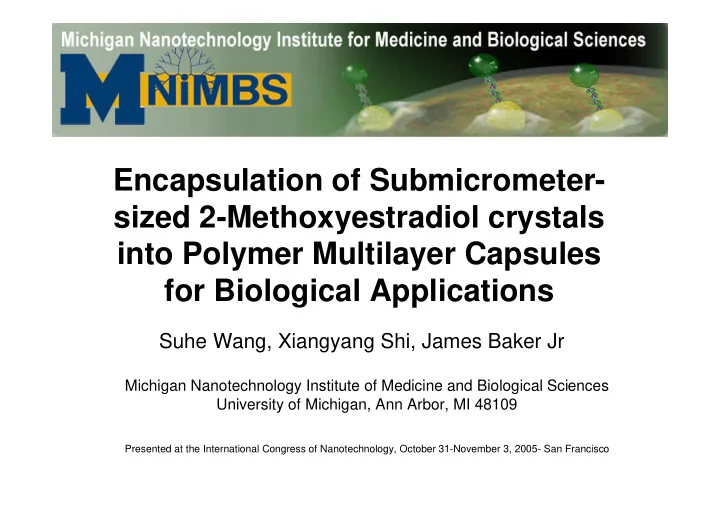

Encapsulation of Submicrometer- sized 2-Methoxyestradiol crystals into Polymer Multilayer Capsules for Biological Applications Suhe Wang, Xiangyang Shi, James Baker Jr Michigan Nanotechnology Institute of Medicine and Biological Sciences University of Michigan, Ann Arbor, MI 48109 Presented at the International Congress of Nanotechnology, October 31-November 3, 2005- San Francisco
What is 2-methoxyestradiol (2-ME)? • metabolite of estrogen • elevated level as a result of estrogen increase • low affinity for estrogen receptor
Chemical Structure of Estradiol and its Metabolites
Characterization of 2-ME • a low-toxic, anticancer agent • insoluble in water • soluble in ethanolic solutions • requires sustained release for effect
Mechanism of 2-ME as an anti-tumor agent Microtubule activity 2-ME caused selective disruption of microtubules, tubulin. Apoptosis Death receptor pathway: DR5, TRAIL, FLIP. Mitochondrial apoptotic pathway: cytochrome c, Cdc6.
Outline of experiment Primary human thyrocytes and FRTL-5 cells treatment either with estradiol or 2-methoxyestradiol morphology MTT cell cycle DNA assay analysis fragmentation
Effect of 2-ME on FRTL-5 Cells
Cell viability assayed by MTT
Cell cycle analysis
Apoptosis induced by 2-ME
Inhibition of tumor growth 1000 DOPC Tumor Volume (mm3) 800 DOPC/17 β -estradiol 600 DOPC/2-ME 400 200 0 0 1 2 3 4 5 week(s)
Reasons to have a new formulation of 2-ME - Encapsulation • Low bioavailability: 2-ME without further modification can quickly be cleared. • High doses of 2-ME or frequent administration may cause hot flashes, fatigue, diarrhea, and reversible liver enzyme elevations.
Reasons to have a new formulation of 2-ME - Encapsulation Avoid toxicity Deliver a prolonged therapeutic level of the drug Increase therapeutic efficiency
Formulations of 2-ME • Concentrated ethanol solution • Liposome-encapsulated 2-ME • Additional formulations?
Self-Assembled Polymeric Capsules • Layer-by-layer self-assembly Donath E, Sukhorukow GB, Caruso F, Davis SA, Mo¨hwald H. Angew Chem Int Ed 1998;37:2201–5. Decher G. Science 1997;277:1232–7.
Self-Assembled Drug Capsules Shi, X.; Caruso, F. Langmuir 2001, 17, 2036-2042
Dextran Dextran sulfate
Confocal Microscopy Imaging (2-ME)-DPPC-(DS/DN) 3 DS/DN-FI 2-ME, 8Layer, outermost layer Dextran-FITC DS----Dextran Sulfate DN----Dextran DN-FI----Dextran-FITC
SEM Imaging 2-ME coated with (DS/DN) 3
SEM Imaging 2-ME coated with (DS/DN) 3 DS multilayers
Coated 2-ME Particle Size Distribution 7 A verage diam eter = 276 nm = 76 nm 6 5 Frequency (100%) 4 3 2 1 0 100 200 300 400 500 600 D iam eter (nm )
TEM Imaging 2-ME coated with (DS/DN) 4 DS 2-ME coated with (DS/DN) 3 dissolved by Extraction of 2-ME using ethanol, leaving behind pure polymer shell structures.
Bioactivity evaluation of 2-ME polymer capsules 1.Phase contrast microscopy Control cells Cells treated with 2-ME ethanol solution Cells treated with 2-ME capsules in PBS buffer
Cell viability after treatment with free 2-ME, en encapsulated 2-ME particles 0.5 0.4 O.D. (570 nm) 0.3 0.2 0.1 0.0 CTRL 2-ME/6L 2-ME/7L 2-ME
Conclusion • Submicrometer-sized 2-ME drug capsules were successfully fabricated and characterized using confocal, SEM, and TEM. • The formed 2-ME capsules are bioactive and can induce thyroid cell apoptosis as verified by both phase contrast microscopy morphology studies and MTT assay. • This approach of fabrication of 2-ME drug capsules opens a new pathway to encapsulate various drugs into polymeric multilayer capsules for a range of therapeutics applications.
Future work poly(allylamine hydrochloride) (PAH) poly (sodium 4-styrenesulfonate) (PSS) Dextran sulfate
Zeta Potential of polymer-coated 2-ME particles 80 PSS/PAH 60 DS/CN -Potential (mV) 40 20 0 -20 -40 -60 0 2 4 6 8 10 12 14 Layer Number
Acknowledgement • Mary Van Antwerp • Xisui Chen • Sasha Meshinchi • Zhengyi Cao NIH-NIAID R01 AI 37141-09 NIH-NCI N01-CO-27173
Recommend
More recommend